Tour of P. Allen Smith’s home, vegetable garden, and rose garden at Moss Mountain Farm

Last month, on a garden-visiting road trip with my mom, I bought tickets for a farm lunch and tour at P. Allen Smith‘s Moss Mountain Farm, about 40 minutes north of Little Rock, Arkansas. Smith is a nationally known TV personality and garden designer, and the half-day tours at his country home draw visitors from all over the U.S. Here’s Part 2 of my tour; click here for Part 1.
P. Allen Smith’s home

During the first part of the tour, we were invited inside Smith’s buttercream-yellow, 3-story Greek Revival home, built in 2008 but designed to look like mid-1800s construction, right down (or rather, up) to an authentic absence of crown molding. Smith lives here part-time, we were told, and keeps a house in Little Rock as well. His traditional decorating style shows that he’s a maximalist as well as a collector of art and antiques, and his interiors are lovely and inviting.
Living room

Our guide led us from room to room, pointing out certain pieces and telling us about their history or how Smith acquired them. Some of the stories were quite entertaining.

In the living room, two of Smith’s fruit watercolors hang on either side of a window.
Kitchen

The all-white kitchen overlooks a hedged lawn, with a charming bud vase on the sill.

At another window, morning light washes over white ceramic serving items shaped like animals.

A ceramic rooster keeps watch over an egg display and egg cups on the windowsill.
Downstairs porch
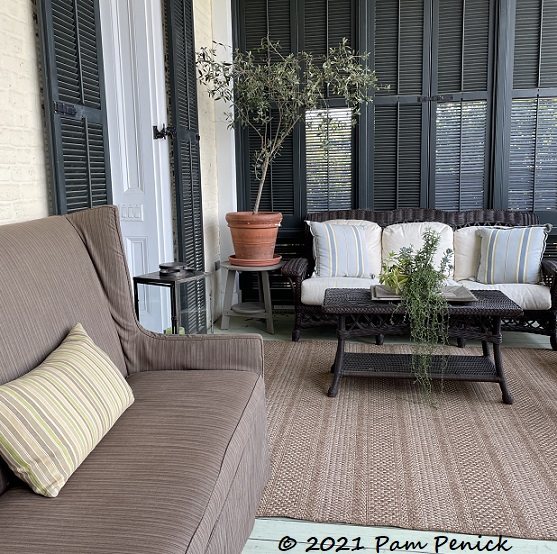
The kitchen opens to a breakfast space and family room, but I was soon drawn out onto the screened porch, where cushioned sofas and chairs are scattered about.

Charleston-green shutters on each end provide shade. The “haint blue” ceiling color is traditional in the South.
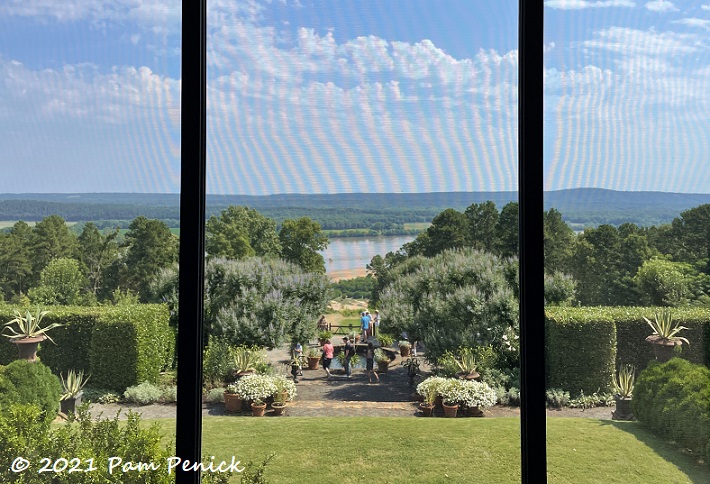
But the view — garden, pond, Arkansas River, and blue-green hills — grabs your attention as soon as you step onto the porch.

Two outbuildings — Smith’s art studio (pictured) and a summer kitchen — face each other across a small lawn to frame the view.
Stairwell

Heading upstairs, we passed two large landscapes and a collection of Founding Father busts.
Library nook

At the top of the stairs you pass through a collector’s charmingly cluttered display area and reading nook.

The stuffed bear lounging open-mouthed on a red divan was an unexpected touch.
Main bedroom

Smith’s bedroom and bath were the only rooms we weren’t permitted to explore, understandably, although we could look from the hall. There were also a guest room and, on the attic-like third floor, a suite of children’s rooms for visiting nieces and nephews.
View of Big Sister Oak

The guest bathroom window looks out on the post oak named the Big Sister Oak in front of the house. She’s stunning, isn’t she?
Upstairs sleeping porch
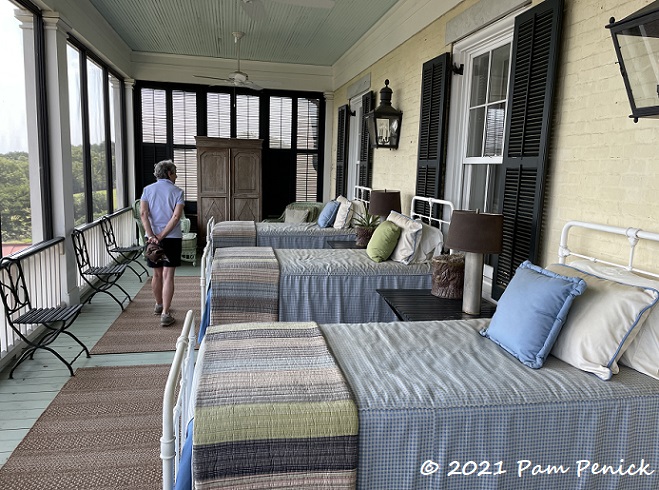
A row of iron beds on the second-floor screened porch invites outdoor sleeping during nice weather.
Vegetable Garden

Next up on the tour was the organic vegetable garden. Because the day was hot and we were told the walk would be long and hilly, Mom sat out this part of the tour along with several others. The 1-acre vegetable garden is laid out symmetrically along a broad path, with two hip-roofed, black-stained sheds on either side near the gate.

Colorful potted plants dress up the path, under galvanized farmhouse lights hanging on the sheds.
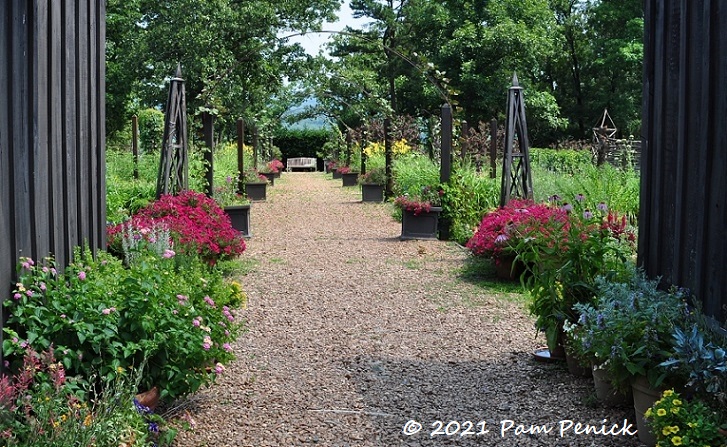
Tuteurs flank the path as do posts supporting wide rebar arches, à la Monet’s garden. Hyacinth bean vine was being trained up the arches. Imagine how beautiful that will look by late summer.

Chipped-paint ceramic chickens perch atop tree-trunk posts in the garden beds, to charming effect. Ornamentals like daylilies, purple coneflowers, and sunflowers are given space alongside edibles.
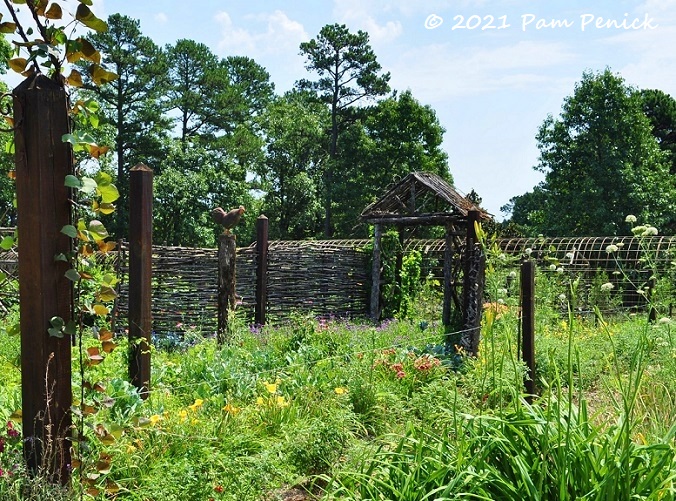
Cedar arbors and wattle-style fencing add country style.
Hydrangea Allée
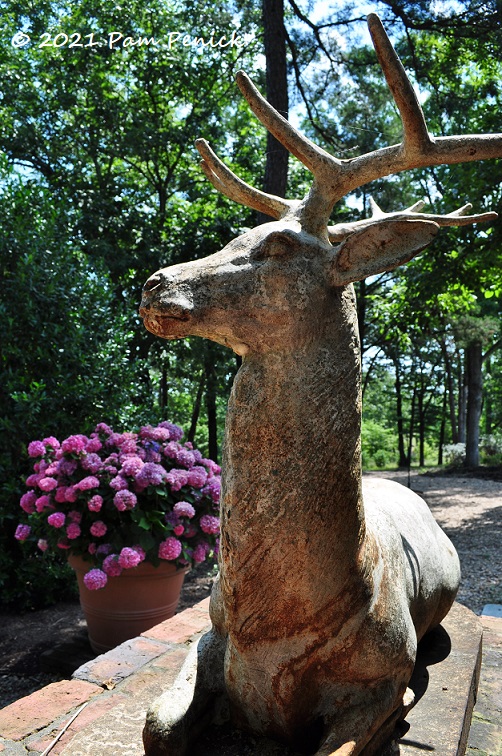
At the end of the path, a bench sits in front of a tall, green hedge. Walk around the hedge, and you’re treated to the surprise of a stag on a brick pedestal. And then…

…your gaze is drawn down a long, sloping path lined by pots of spectacular hot-pink hydrangeas and emerald hollies, the glinting river glimpsed in the distance. This is the path to the Hidden Rose Garden.
Hidden Rose Garden

The rose garden appears on a lower terrace, nearly hidden from view until you reach an overlook at the end of the hydrangea allée.
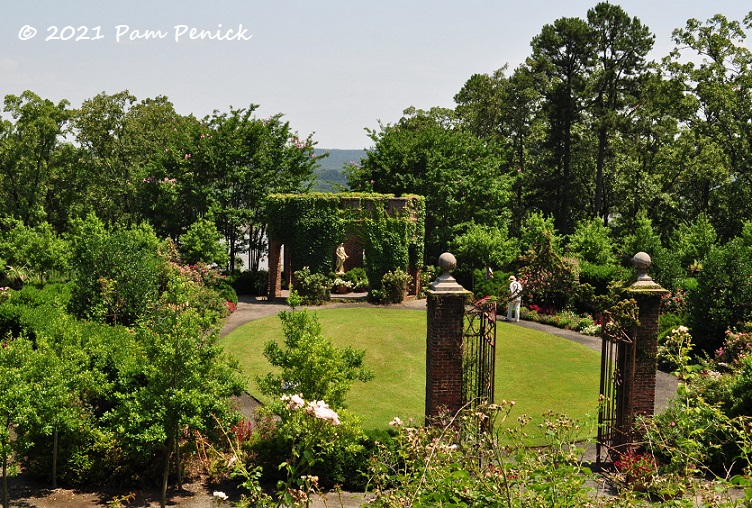
Looking over a parapet you see grand gates supported by brick pillars, which open to an oval lawn. A temple-like folly smothered in ivy draws the eye to a statue of the Goddess Flora.
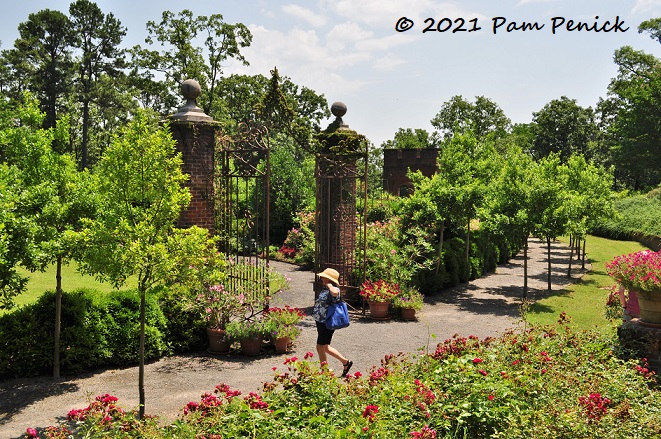
An allée of Eagleston hollies, which Smith prizes for their bee-attracting flowers and red fruits, encircles the garden. Eventually the trees will be pleached so you can walk under a leafy tunnel around the garden.

Potted oleanders flank the gate, adding hot-season color.
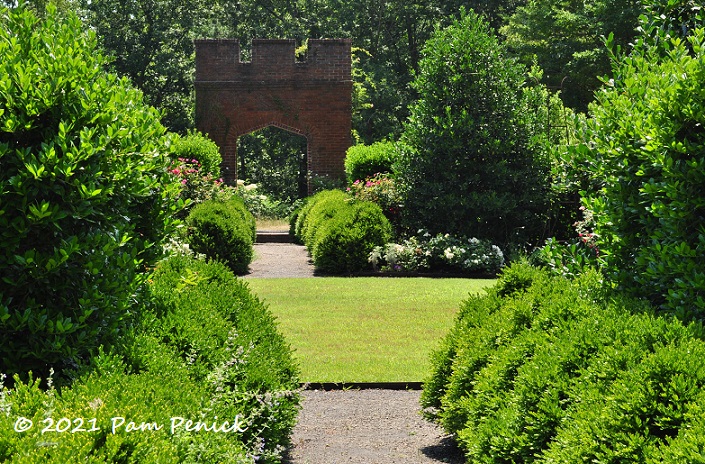
Holly and boxwood create an evergreen frame for garden paths and sight lines to crenellated brick pavilions on each side of the garden.

Pink roses and an agave (fighting with grassy weeds — it’s a real garden!) in a Victorian urn

Castle-like with its crenellated top, the Flora pavilion is softened by creeping ivy that adds secret-garden romance.

Flora stands amid potted boxwoods and white flowering annuals.

The garden can be rented out for weddings, and I imagine it’s a popular spot for Little Rock brides.

Blowsy pink and red roses mingle with boxwood inside hedged beds.
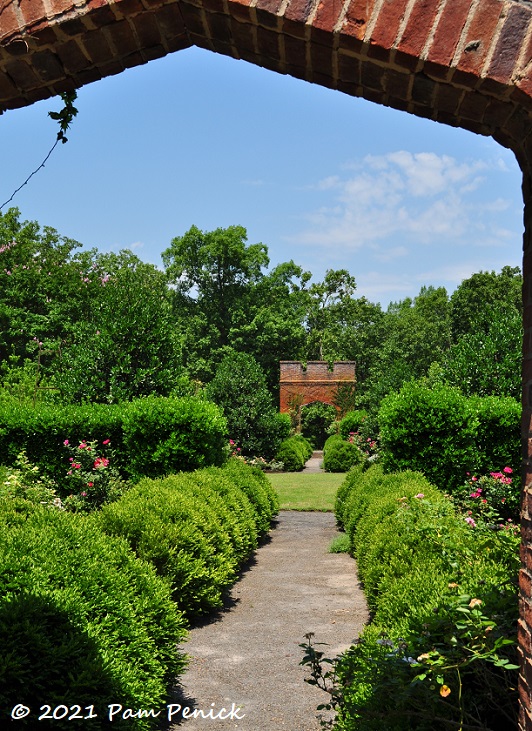
The cross-axis view from one of the smaller pavilions to another

Looking back toward the gates, you can see people on the parapet overlook, accessed via curving ramps on each side. It’s all quite grand and formal for a farm garden, Smith says, which is why he separated it visually from the rest of the garden.
Lunch and meeting P. Allen

Back at the house, we found lunch waiting for us under a tent. Overhead, magnolia wreaths lay in iron chandeliers, and rustic tables were decked out with potted topiary, lanterns, and flower bouquets. Salad greens with chicken, sautéed vegetables, and Smith’s “famous buttermilk pecan pie with homemade whipped cream” filled us up. As lunch wrapped up, Smith ambled down from the house to greet us.
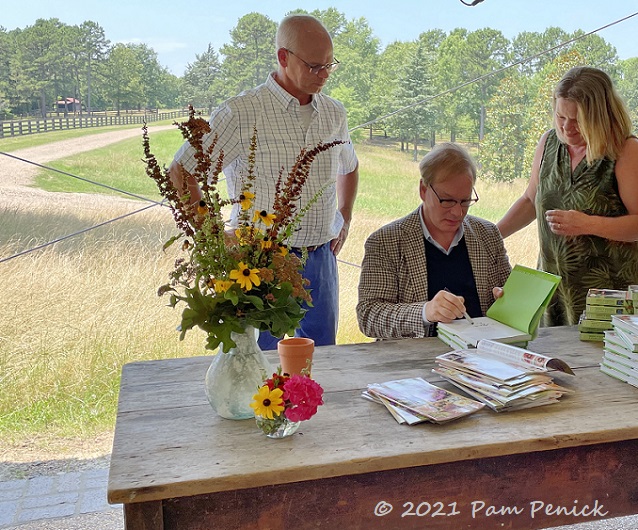
It had to be 90 degrees, but Smith was dapper in slacks, a button-down shirt and vest, and a plaid sport coat. So far as I could tell, he never broke a sweat. I was in awe of his sweat-gland control. He perched on a stool and started chatting about the farm, and instantly he had us eating out of his hand, laughing at his jokes and asking questions about growing hydrangeas, when to fertilize, and the like. He was a real pro — accessible, witty, and a storyteller with a languid Southern drawl. After a Q&A session, he sat for a book signing and photos.

We opted not to wait in line to meet Smith and also skipped the final portion of the tour — Poultryville, where a huge barn houses Smith’s beloved heirloom chickens — because we had other places to be. But we enjoyed our visit to Moss Mountain Farm and would recommend it to anyone who likes home and garden tours. And if you happen to be a fan of P. Allen, you’re sure to love it.
For a look back at the Terrace Garden at Moss Mountain Farm, click here. This concludes my series about my Austin-to-St. Louis road trip.
__________________________
Digging Deeper
Subscribe to Digging and get updates delivered directly to your inbox. It’s easy! Just click over to follow.it (my subscription service), enter your email, and click Follow. An email confirmation will be sent, and click on that to confirm. You’re done! A head’s up: if you’re a longtime subscriber, I’ve had to switch services, and my updates now come from follow.it. You may find they’re going into your spam folder (ugh, sorry!). If so, add follow.it to your trusted contacts to keep receiving Digging. Thank you for reading!
Come learn about gardening and design at Garden Spark! I organize in-person talks by inspiring designers, landscape architects, authors, and gardeners a few times a year in Austin. These are limited-attendance events that sell out quickly, so join the Garden Spark email list to be notified in advance; simply click this link and ask to be added. Season 8 kicks off in fall 2024. Stay tuned for more info!
All material © 2025 by Pam Penick for Digging. Unauthorized reproduction prohibited.


Thank you for this and many many other trips you have let us take with you, visually, that would not otherwise have seen and in many cases not even known of. Your narratives are so great and often laugh with your phrasing. Again – thanks and many more happy trips with your family and/or Mom.
Aw, thanks, Judy! I’m happy to hear that you’ve enjoyed the tours I’ve shared here at Digging!
Thank you for taking us all along…lovely!
I’m so glad you came along, Layanee!
I didn’t realize he was that successful to possess such a grand place. Your photos and narrative were so enjoyable, Pam. Couldn’t help but think of the water consumption though.
Nearly all gardens require some amount of supplemental water, of course, but I get the feeling he’s thoughtful about water use. His home was built to LEED certification standards (a big accomplishment), and the farm has a rainwater collection system for garden irrigation.
Looks like it was a great tour. He must have a gardening staff to look after such a large farm.
Yes indeed, he does. He has a lot of staff of all kinds.
Looks like he’s quite successful in a number of ways. Very interesting place, in a number of ways, too–but all rather staged for display or instagramming. Do people actually live like that? No piles of books, no half-finished projects anywhere? The weeds in the Agave were a relief.
Thanks for taking us along on your tour.
I don’t think people live like that, no. It was all arranged just so for tour-goers. If he offers approximately 20 days of tours per year, that leaves lots of time when no one is traipsing through his house. I don’t leave my projects scattered everywhere either when I host Garden Spark events. 😉
I laughed out loud over your weedy agave comment! It was a sign of reality, wasn’t it? Even so, I was surprised to see them, considering the attention to detail everywhere else.